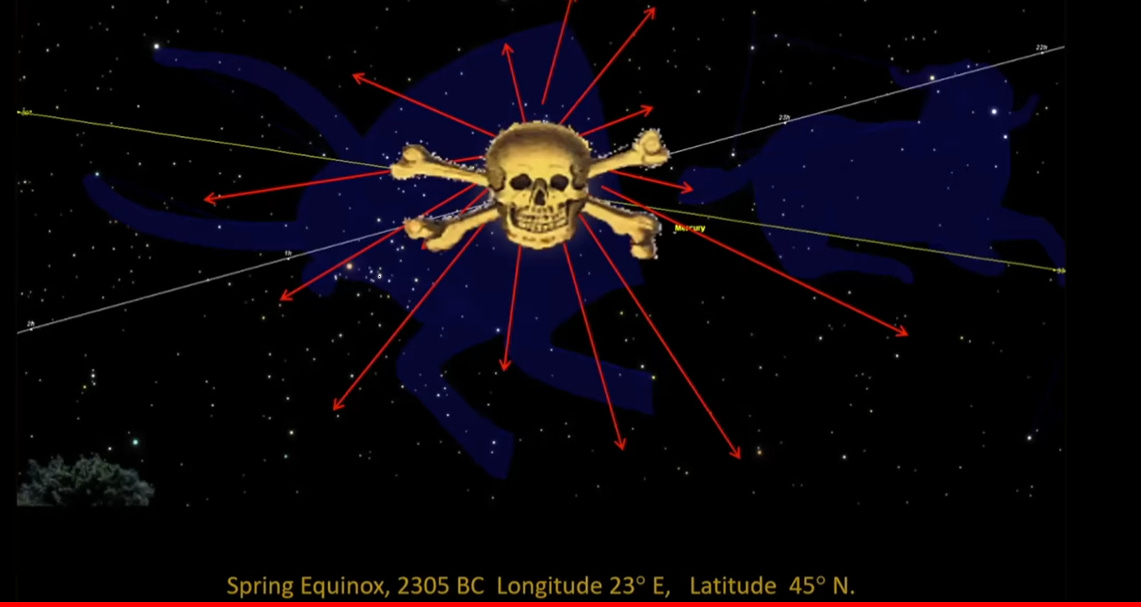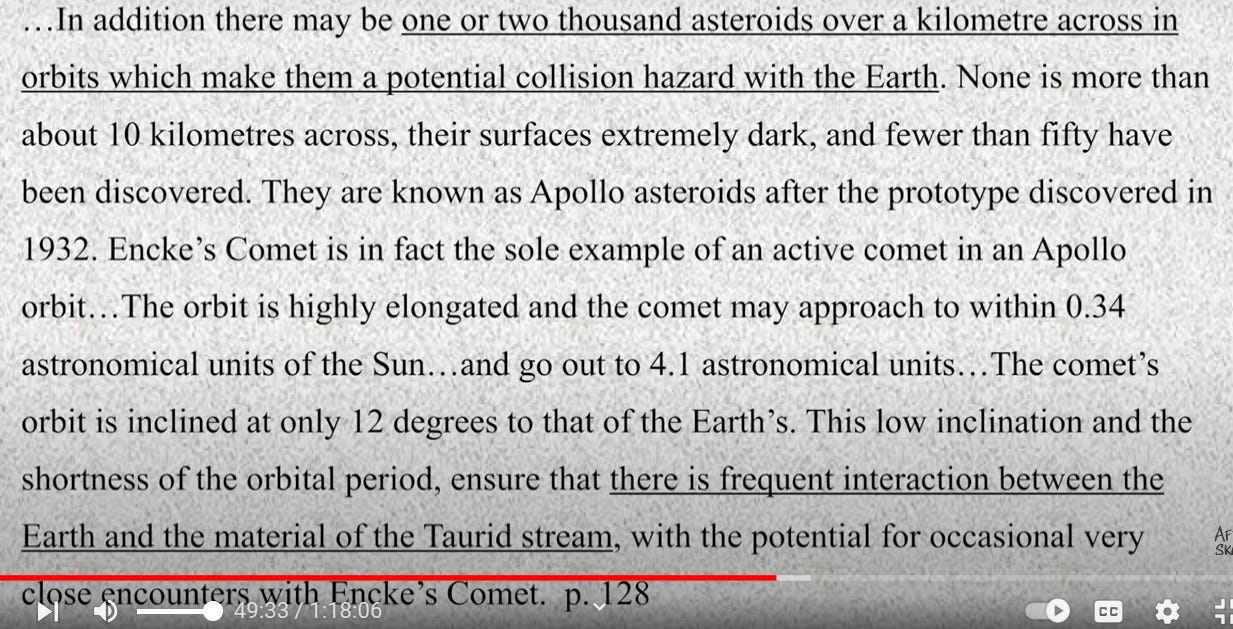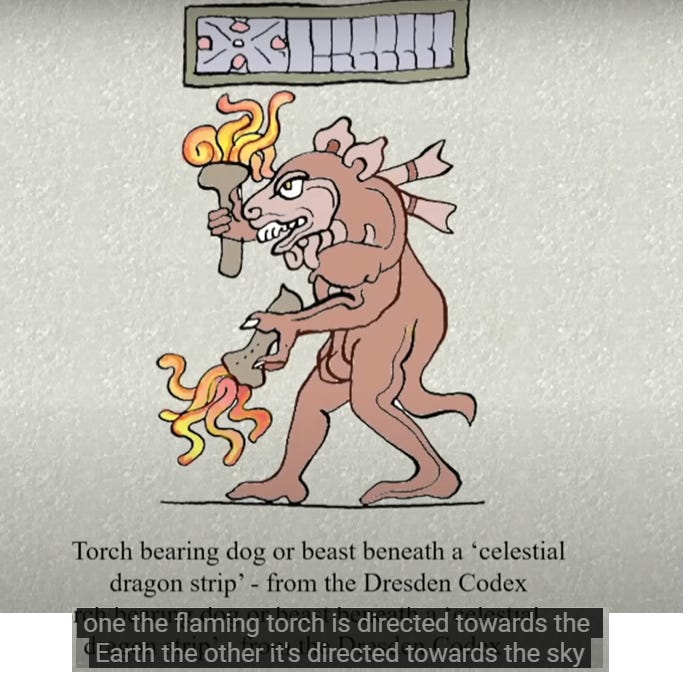HALLOWEEN & YOUNGER DRYAS - Part 2
Comet Encke, Taurids, Catastrophism.com, Conflagration, Flood
CONTENTS
.1. COMET ENCKE & TAURID METEOR STREAM
.2. HALLOWEEN ORIGINS
.3. CONFLAGRATION & FLOOD
.1. COMET ENCKE & TAURID METEOR STREAM
{Taurid Meteor Stream overlaps the Leonid Meteor Stream.}
{Here’s an illustration of the orbit of the Taurid Meteor Stream, which the Earth crosses twice each year.}
.2. HALLOWEEN ORIGINS
SIDETRACK TO CATASTROPHISM.COM: HALLOWEEN https://www.catastrophism.com/intro/search.cgi?zoom_query=halloween
HALLOWEEN WITCHES. https://saturniancosmology.org/othergroup/thoth/thotii17.txt
Kronia questions, comments by Dwardu Cardona. KAREN JOSEPHSON WROTE: All this talk about comets combined with thoughts of [Halloween] has reminded me of something I saw on PBS (Nova, I think).... They showed the mummies of Caucasian people who lived in what is now western China.... One of the best preserved was a tall Indo-european-looking woman. The items found in the grave indicated that she was some kind of religious leader in the community. The item that made her particularly memorable to me was the hat she wore on her head .... It was a very high, pointed "witches hat" -- Another "old wive's tale (or bit of mythology turns out to have basis in FACT!!!!!) KAJ. DWARDU CARDONA COMMENTS: The witch's pointed hat IS based on fact, but not re the mummy you mention above. The pointed hat was the conical-appearing axis mundi as it stretched above the Venerian orb in its descent from the Saturnian center. (Dave Talbott may have a slightly different take on this. Why not ask him?) Dwardu. …….{This suggests that the Halloween cataclysm occurred when Venus had become unstable and appeared to descend below Saturn while the plasma column was seen behind Venus connecting to Saturn, while appearing to be a hat on Venus.}
CARNIVAL. https://saturniancosmology.org/othergroup/thoth/thotiv13.txt
A Kroniatalk Discussion. Ted Bond queries: Someone very recently said that Carnival was a New Year's celebration. Carnival of course is in the Spring and is a Spring equinox festival. If it is a New festival it dates from the time when the year began with March (as reflected in the names of the last four months of our year). The Jewish New Year was also originally a Spring festival, according to Genesis. However the Winter solstice festival, which is our Christmas, certainly was dropped on to the pagan Saturnalia (Yule), and this is very close to our New Year. Was there an ancient New Year's festival following closely on the Saturnalia celebrating the arrival of Jupiter (the reborn Saturn) as the Universal Monarch? Can anyone sort this out?
Michel Tavir responds: Carnival, which emerged from the Saturnalia, symbolized the death of the old year, and took place in the late winter. Practically it was time to pig out on the remains of the last harvest, while they were still edible. Then came the New Year, which until the late middle-ages coincided with the Spring equinox. Some (I think I remember some pope conniving with a French king, maybe François the 1st) found it more politically expedient to move it to shortly after Christmas. There is still a trace of the "original" New Year in the April's Fool day.
Dave Talbott adds: Ted, you might find of interest Theodore Gaster's little volume, _The New Year_. Gaster was one of the true experts on comparative myth and ritual.
Our calendar is filled with New Year's celebrations. Even Halloween has to be included. (It traces to the Celtic New Year.) Either a solstice or an equinox timing of "New Year's" celebrations was most logical, though of course the archetypal event being recalled each year had nothing to do with either a solstice or an equinox. This is the way localization of myth works. First there was extraordinary and devastating event, remembered as the End of the World. To commemorate the event, together with the subsequent renewal of the world, ancient symbolists re-enacted the fall into chaos, the displacement of the elder Father Time, and the regeneration of the world (Father time reappearing as a newborn babe). In this sense the New Year's festival must be set alongside other{} celebrations which were not annual but set on longer timetables. The Aztec 52 year cycle is a good example--symbolic destruction of the world followed by a new lease on life for another cycle. The Egyptian Sed Festival is a "New Year's" festival every thirty years, which happens (?) to accord pretty well with a Saturn cycle.
Of the New Year's concept, Gaster writes: "...No other festival has been celebrated on so many different dates or in so many seemingly different ways....The more one examines them, however, the clearer does it become that these observances which seem at first sight so different and diverse are really no more than variations upon the same theme and that though the accompanying emotions may have changed and though he may be completely unconscious of this fact, the behavior of the modern sophisticate on New year's Eve or New year's morn stems ultimately from the same roots as does that of his more primitive brethren."
The ancient celebrations were characterized by mock battles in the streets, great commotion, lamentations, joviality, celebrants in disguise{}, monstrous forms amid the chaotic throngs -- and of course (in more than one land), the fall of a flaming wheel down a hill, or the running amok of a "chariot" through the streets (Phaeton revisited). What is most interesting is that, as you follow the celebrations backwards, you see an increasing scale of drama and literalism, with the fate of the world hanging in the balance. Attempts to account for a global archetype of this sort through feeble references to the annual course of the Sun only put an exclamation point to the failure of modern scholarship. The experts cannot see beyond the symbol to the thing symbolized. Dave Talbott {Phaeton set the world on fire.}
Mythic Ireland, by Michael Dames [SIS Review]. Grean is a hill to the NE of Lough Gur, known colloquially as bright cheeks. The Giant's Grave on top of the hill is an effigy of Graney (= brightness and beauty) according to Dames, and hundreds of stones are laid out in the form of her long flowing tresses. {Note that in Part 1 we learned that in ancient times meteors were sometimes called falling hair. This Irish practice of making an image of a goddess with hair made of stones hints at that too.} Irish bruiden stories were associated with Samhain (Halloween) and things that go bump in the night. The god hero was invariably enticed into a magic house or bruiden, a banqueting hall, where he is unexpectedly abused and ill-treated, and sometimes is killed. Finn for instance, was lured to the bruiden every November (a region in the sky). Bruiden tales were traditionally recited during November and appear to reflect a phenomenon of nature humanised by warrior society. Part 5 turns to Mide = the centre of Ireland and its presumed connection with the omphalos stone. This is specifically the Hill of Uisneach in Co. Westmeath which has a large conical boulder on its SW flank, the Aill na Mireann (bright Mary or stone of the sea), in actuality a glacial erratic (a fissured limestone boulder). {The omphalos was the navel of the sky, where Mars was in the center and the plasma column reached from it to Earth, like an umbilical cord. The glacial erratic boulder suggests the end of the Ice Age.}
Boscawen-un. Norman Lockyer, in a study of Boscawen-un stone circle near Lands End in Cornwall, claimed that it was not only aligned to sunrise on the summer solstice but it was also aligned to the important folk moots and gatherings of May Day and November (Halloween). Boscawen-un is named in a Welsh triad as one of the three' (a magical number and not necessarily a limitation to the actual number of) Gorsedds in Britain (read here, probably, SW and W. Britain). In other words, the 19 stones of Boscawen-un circle remained potent into the druidic period. {So this connects a stone circle with Halloween etc.}
Commemoration Of The 2300 BC Event. America. The Tzontemocque, like the Tzitzimine, are associated with meteoroids; they are referred to as head-downward descenders and those who fell head-first. {Remember the images in part 1 depicting a man and a monkey falling from the sky, representing meteors.} This festival included ceremonies in honour of the dead [69]. Commemoration of the Pleiades encounter apparently continues today with the celebration throughout Mexico on November 2nd of El Dia de los Muertos the day of the dead. On the last day and night of October, people spruce up the graves of family members, arrange flowers, lay out toys, prepare favourite foods and light chest-high candles that will burn through the night into the Day of the Dead. On the next two days of the three-day event, people visit the graves, picnic over them, even bring blankets to sleep on them so that they won't miss the dead when they come to visit [70].
Britain. A striking similarity to the Mexican traditions exists in Britain. The most important Celtic festival, Samhain, was observed for three days, Oct. 31st, Nov. 1st and 2nd, and marked the beginning of the year [71]. As with the Aztecs, all fires were extinguished before Samhain. The new fire was kindled on Samhain eve and distributed throughout the land. This tradition was carried forward by the Druids and continues in the Halloween torches of the Irish, the bonfires of the Scottish, the coel-coeth fires of the Welsh and the tindle fires of Cornwall, all lit at this time [72]. The observance of Halloween at the end of October is said to have evolved from Samhain [73]. It is still considered a frightening time, with all sorts of things travelling overhead. The tradition of ghosts can be considered as a distorted residue of the commemoration of the dead. The Celts concentrated many of the great mythic events at Samhain. MacCana states, Samhain is the appropriate setting for myths which symbolize the dissolution of established order as a prelude to its recreation.... {That’s a prelude to the following depiction back in Randall’s video of the torching of heaven and earth.}
.3. CONFLAGRATION & FLOOD
{The Dresden Codex is a Maya book, which was believed to be the oldest surviving book written in the Americas, dating to the 11th or 12th century.}
{The next ancient image depicts the god, Mithra, stabbing the shoulder of Taurus, where the Pleiades are, while they are shown as stars around Mithra. The two torch-bearers are again setting heaven and earth on fire.}
{Next, goddess Europa is taken by Zeus as a bull, whose shoulder she aims to stab. Phaeton is losing control of his chariot and is about to spread fire and the man below may be Aquarius, spilling Flood water. Another torch-bearer is behind.}
{Next is a Flood story from Peru which suggests connection to the Pleiades.}
{Then there’s an ancient clay tablet, probably from 2300 or 2600 BC, that may describe an asteroid impact.}
{The pyramids were said to be built to retain knowledge after the coming cataclysms.}
{Chinese called some comets broom stars, probably related to witches’ brooms elsewhere.}
{Next Randall commented that an apparition refers to both ghosts and comets, maybe because comets looked like ghosts. Skull was added to Halley’s comet image.}
{I think he’s suggesting next that the skull and cross-bones possibly originated from the comet appearing toward the Pleiades.}
{That’s all.}

















